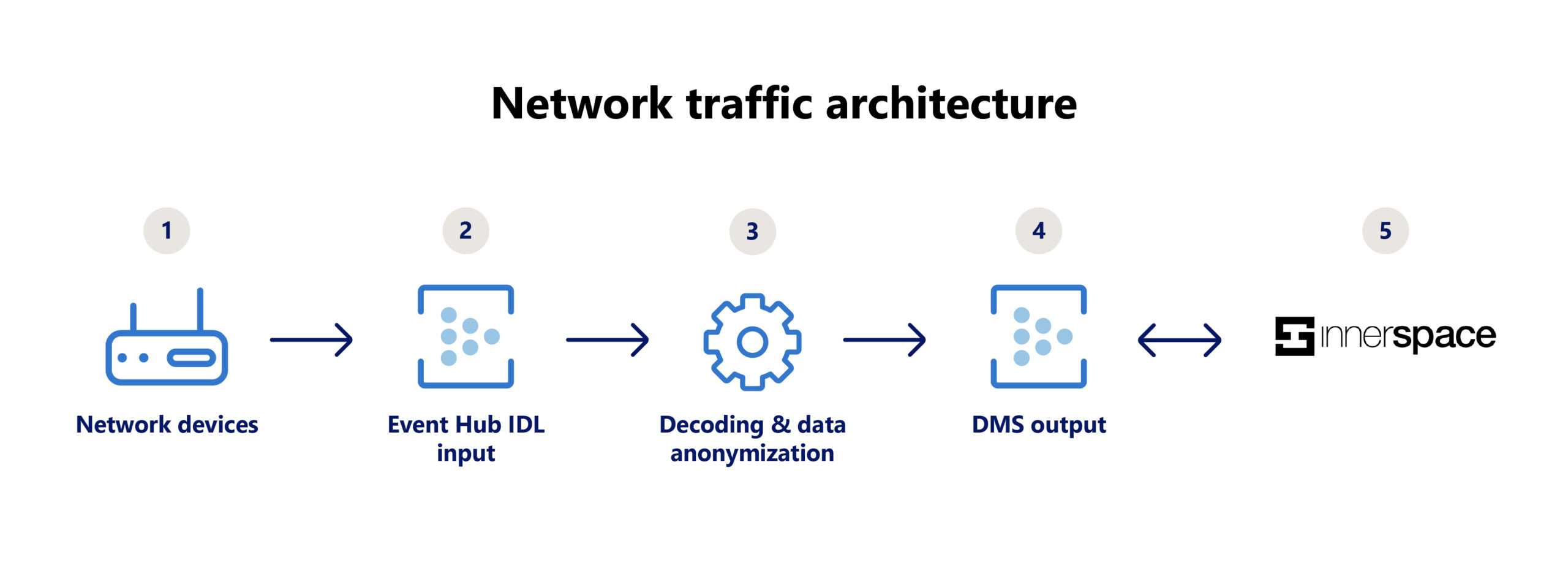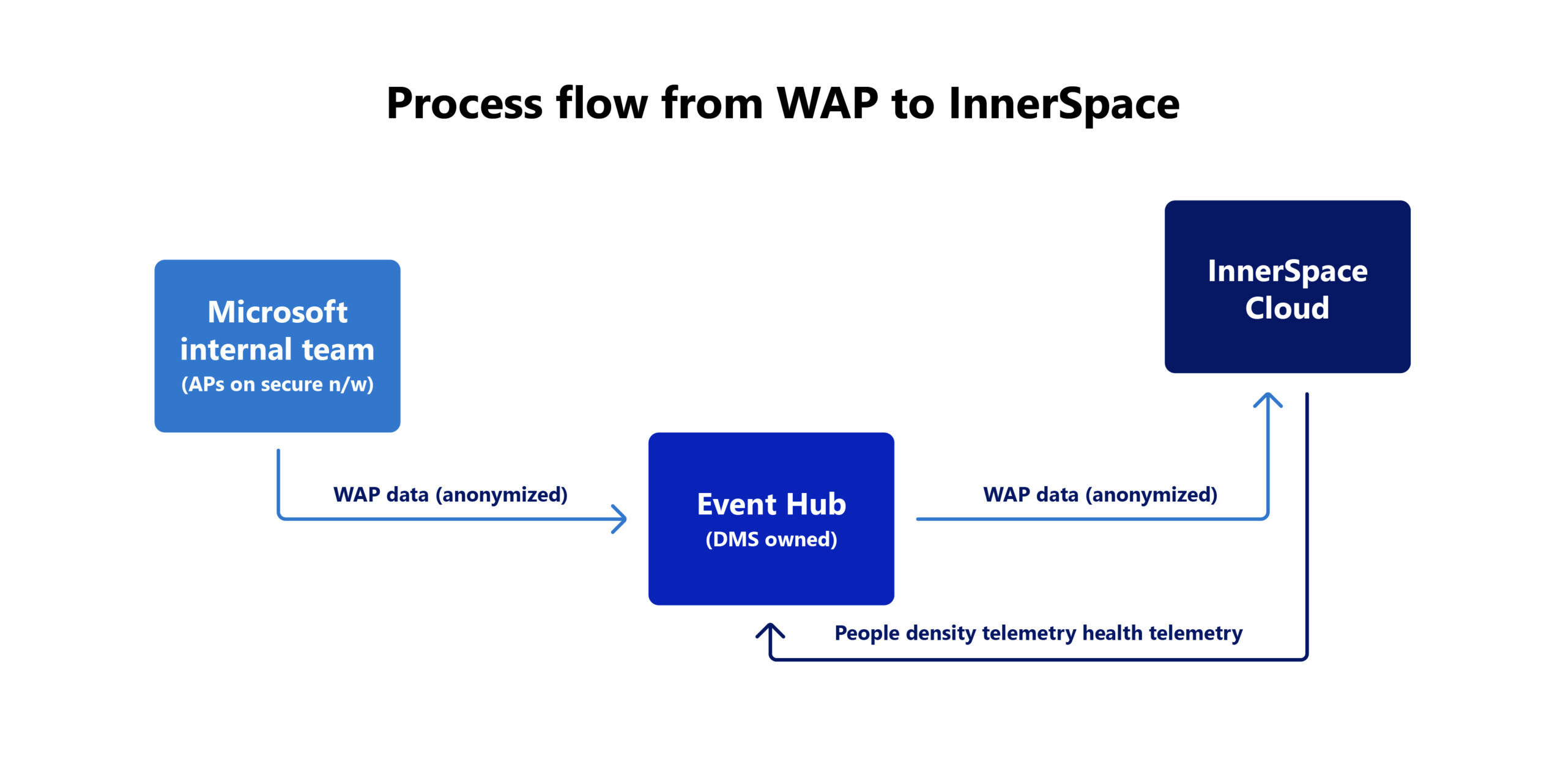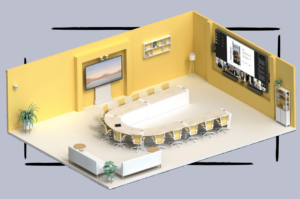
Space management and employee engagement are two critical aspects of any modern workplace, including internally here at Microsoft.
Figuring out how to get both right leads to important questions:
How can organizations understand the best use of their building spaces, including offices and common spaces, while providing better experiences for their employees? How can they reduce the cost and complexity of installing and maintaining IoT sensors to measure people density in different areas? How can they protect the privacy of employees and their devices and comply with privacy regulations?
This is what we asked ourselves when we set out to enhance both space utilization and the experience our employees have when they go into the office in our brand-new buildings here at Microsoft headquarters in Redmond, Washington.
We in Microsoft Digital, the company’s IT organization, knew that each new building would come with a wireless access point (WAP) system that employees use to access Wi-Fi. We knew the data from the access points could be used to measure the people density in different areas. The question was, how could we use this data to provide real-time insights to employees and facility managers privately and securely?
We identified an opportunity to reuse the existing devices and the data that we already had from these devices. It was a cost-optimized way of handling our requirements.
— Nritya Reddy, senior product manager, Microsoft Digital
Using WAP data to measure space utilization

Our solution, Space Busyness Insights, uses our standard Wi-Fi WAP devices located throughout each building to calculate data on space utilization. This data includes identifying unused areas, occupied spaces and the crowd density, and the availability and use of common areas. By analyzing this data, we can make informed decisions about how to best allocate additional space or repurpose existing areas for more effective use. Additionally, we can plan for future real estate requirements.
“We identified an opportunity to reuse the existing devices and the data that we already had from these devices,” says Nritya Reddy, a senior product manager on the Microsoft Digital team. “It was a cost-optimized way of handling our requirements.”
Our employees’ benefit from this solution is being able to view, in real time, the availability and activity in shared spaces such as kitchenettes and conference rooms. To implement this solution, we collaborated with our Infrastructure and security team, Innerspace (a third-party vendor), and Microsoft facilities managers. We integrated AI to enhance our data measurement and analysis capabilities, enabling us to create actionable plans for space management.
“The era of modern smart experiences with IoT hardware demands innovative solutions that can be stitched across multiple devices and protocols with a cost-efficient design and architecture. I consider this as an opportunity to use the signals from two ecosystems to build secure, privacy-protected, smart building experiences. This gives us further opportunities to explore various use cases with WAP technology without additional hardware integrations,” says Sudhakar Sadasivuni, principal group engineering manager, Microsoft Digital.
Our innovative approach of repurposing existing devices for new requirements emphasized cost optimization and helped us be frugal with our resources.
“We have an existing Wi-Fi infrastructure in all our buildings, provisioned via WAP devices by different vendors. They can provide a list of devices that are Wi-Fi- connectable and in the discoverable range of the given WAP device,” says Reddy. “By employing artificial intelligence and machine learning on this raw data, we can triangulate people density. Meaning, you would know how many people are in that specific area based on some of the devices that these people are carrying, either a laptop or a mobile phone, which are discovered by these WAP data points.”
We sell primarily to the largest enterprises, so we needed to build on a robust, highly secure, highly scalable, and universally trusted cloud infrastructure.
— Matt MacGillivray, co-founder and VP of Research and Development at InnerSpace
We partnered with InnerSpace, a vendor who has the logic and AI ML capabilities in their system to understand and make sense of the raw data that came from the WAP points and then provide meaningful people-count data.
“We sell primarily to the largest enterprises, so we needed to build on a robust, highly secure, highly scalable, and universally trusted cloud infrastructure,” says Matt MacGillivray, co-founder and VP of Research and Development at InnerSpace.
He shared how they used Microsoft Azure services to run their logic and provide the output.
“We used Azure Kubernetes to provide elastic capacity for our ingest pipeline and datastore, Azure App Services to run our client-facing web-based tooling, and Azure Container Instances to deploy containerized subsystems without needing to manage the machines running them,” MacGillivray says.
InnerSpace also uses proprietary AI logic to ensure that people aren’t counted double because they might be carrying more than one device. Based on the proximity of those devices and other logic and rules in place, they can help us determine space usage.
The device identifiers are shared between systems in a hashed way. This ensures that specific devices discovered cannot be identified and personal identification information (PII) is protected. We performed stringent Microsoft architectural and data privacy reviews to ensure that no private data is being leaked at any stage. In addition to privacy, scaling and security are other key aspects considered when exchanging data with external systems.
— Lakshmi Kothamasu, principal software engineering manager, Microsoft Digital
We implemented this solution in our Redmond East Campus buildings, and through this process, we get the information we need for space utilization with these two goals in mind for our employees:
- Protect our employees’ personal information and privacy
- Comply with privacy regulations
To make our solution work with these two goals in mind, we hash the media access control (MAC) addresses of the devices to anonymize the data we send to the third parties, and we perform Microsoft privacy reviews. We only provide InnerSpace with information that they need to analyze the data and make sure to protect everything else. Any data that can be identifiable and linked to a specific device or person(s) is hashed.
After encoding or hashing the data, we get the data that is pushed from our internal Microsoft team to our Device Management Services (DMS) Azure Event Hub.
From there, we have a federated authentication mechanism in place for our vendor, InnerSpace, for them to access the anonymized data from our Azure Event Hub. InnerSpace then runs their logic over that data and provides the people count in a space context back to Microsoft.
We also ensure that InnerSpace has our building maps with the access point (AP) IDs and locations on them so they can run their triangulation algorithms to pinpoint the number of people in any space at a given point in time.
When we get that information back, we can then use that data to review and analyze the information and make space utilization decisions.
“The device identifiers are shared between systems in a hashed way. This ensures that specific devices discovered cannot be identified and personal identification information (PII) is protected. We performed stringent Microsoft architectural and data privacy reviews to ensure that no private data is being leaked at any stage. In addition to privacy, scaling and security are other key aspects considered when exchanging data with external systems,” says Lakshmi Kothamasu, principal software engineering manager, Microsoft Digital.

“We underwent a review where the subject matter experts on the privacy team reviewed the entire architecture and made sure that no device identifier or personally identifiable information of the employee was directly or indirectly being passed on,” Lakshmi says.

Using our solution to plan for future needs
The benefit of this solution is that it enables real estate and facilities managers to optimize the space utilization and plan for future needs, and it empowers employees to make informed decisions about where and when to use common areas, such as the kitchenettes and the meeting rooms, in real time. We also use a smart building kiosk that allows employees to access the data in a simple and intuitive way.
“The smart building kiosk can be used to open an app, look at a map on the web, or go to a kiosk to see a map. When the employee zooms in, they can see if a space is busy or not,” Reddy says.
Maximizing cost savings
By using the existing WAP system instead of installing new sensors, we saved around $3 million in hardware costs for the East Campus buildings. Because the WAP system exists in all buildings, we can easily enable this solution in other buildings without additional hardware costs.
The cost avoidance isn’t just about not having to buy those IoT sensors and installing them, but also the continued maintenance and security of those devices. You have firmware updates and security updates in the future, so the life cycle costs come down to quite a bit of savings from not having to implement duplicative infrastructure.
— Daniel Lee, regional lead, Center of Innovation, Microsoft Global Workplaces Services
The cost savings go beyond just the hardware. In every building, the fundamental IT infrastructure includes WAP, which is essential for providing Wi-Fi connectivity. Our Microsoft internal team has developed a highly configurable solution that doesn’t require any code changes. To integrate a new building, we simply need to update the configuration with the new AP layout, and the system operates seamlessly. While the initial implementation at the East Campus took about three months, the process has been significantly streamlined for other locations and can now be completed in just a week or two.
“The cost avoidance isn’t just about not having to buy those IoT sensors and installing them, but also the continued maintenance and security of those devices. You have firmware updates and security updates in the future, so the life cycle costs come down to quite a bit of savings from not having to implement duplicative infrastructure,” says Daniel Lee, a regional lead on the Center of Innovation team in Microsoft Global Workplaces Services.
When considering a building, whether it’s a leased space for customers or a company’s own property, optimizing the use of space is crucial. Real estate comes with significant costs, not only in acquisition but also in ongoing maintenance. We need to ensure that employees are making effective use of these spaces. If they’re not, it’s important to understand why, so that we can address any issues and improve space utilization.
Gaining additional benefits
We’ve talked a lot about space benefits for planning for space and cost reduction, but let’s also talk about other benefits of using the solution:
- Data-driven decisions: Removing emotional guesswork from space planning with clear-cut data on actual space usage.
- Holistic analysis: Combining WAP data with other sensor signals like lighting and air quality for comprehensive space planning.
- Rapid deployment: Streamlined process for implementing the solution in new locations.
By gathering and using the WAP device data, we can optimize space utilization, but also gain insights about what our employees need from us to optimize their experience.
How other companies can benefit from Microsoft’s solution
We have an aspiration of rolling our solution into the upcoming product Microsoft Places and making it self-sustained and scalable. Places is a product that aims to provide a holistic view of the physical and digital spaces in an organization and how they’re used by the employees.
I believe the key advantages of our solution are, first, the enhanced security that comes with not having to add extra hardware or devices. Second, we’ve managed to reduce the number of devices installed across the buildings. And third, because of these improvements, we’ve achieved additional cost savings for Microsoft. That’s the significant impact this solution has delivered to Microsoft.
— Bharath Kumar, principal PM manager, Microsoft Digital
We’re currently using this solution in seven buildings and our goal is to continue implementing this solution in our other buildings.
“I believe the key advantages of our solution are, first, the enhanced security that comes with not having to add extra hardware or devices. Second, we’ve managed to reduce the number of devices installed across the buildings. And third, because of these improvements, we’ve achieved additional cost savings for Microsoft. That’s the significant impact this solution has delivered to Microsoft,” says Bharath Kumar, principal PM manager, Microsoft Digital.
Other companies that have similar space management and employee engagement needs could benefit from Microsoft’s solution, because it uses existing Wi-Fi infrastructure, reduces the dependency on external sensors, protects the privacy of the employees, and provides a simple and intuitive way to access the data.
“Our aspiration, as we productize this solution, is to eliminate the dependency on anything but the actual product itself. One product we used is Azure Digital Twins, which gets the whole experience lighted by making sense of people count against the space and processing that information,” Reddy says.
Here are some tips on getting started at your company:
- Consider implementing a similar solution to optimize space utilization and improve employee experience in your own buildings.
- Use existing Wi-Fi infrastructure to reduce cost and dependency on external sensors and vendors.
- Ensure that the solution protects employee privacy and complies with privacy regulations.
- Stay informed about the latest developments and best practices in the field of space utilization and employee experience.

Create your own Azure free account today on the Microsoft Azure product page.
- Check out how we’re improving the way we listen to our IoT building sensor readings with load testing.
- Discover how we’re using our smart machine learning model and IoT capabilities to bolster our smart buildings.
- Learn how we’re transforming our IoT-based experiences at Microsoft with our Digital Integration Platform.

Want more information? Email us and include a link to this story and we’ll get back to you.
Please share your feedback with us—take our survey and let us know what kind of content is most useful to you.






